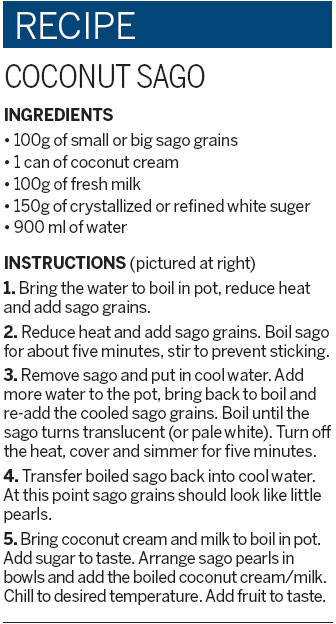Coconut adventures
Updated: 2012-05-18 07:52
By Alessandro Cantonetti (China Daily)
|
|||||||||||

Sail through the summer with this silky white treat 味觉启航, 去品尝郑和下西洋带来的鲜为人知的甜蜜成果.
Don't be deceived by coconut sago's pure white broth or playful pearls of chewy goodness - behind its innocent appearance lurks a history both ancient and dark, one that tells an epic tale of daring explorations, court intrigues and mercantile migrations.
Coconut sago (椰汁西米露) is a sweet, silky white porridge made from coconut milk and sago, a kind of palm starch shaped into pearls that resemble tapioca balls. Served hot or cold, it is a refreshingly light way to end a meal. The dessert can be found all over the country - but the origins are not Chinese.
In the early 1400s, Zheng He (郑和), the revered fleet admiral, diplomat and explorer (not to mention eunuch) began leading his landmark voyages to Southeast Asia, South Asia, the Middle East and East Africa.
Spearheaded by the Yongle Emperor, these expeditions would prove instrumental in spreading the influence of the Ming Dynasty (1368-1644) to remote corners of the globe.
The voyages also helped bolster a vast network of cultural and commercial routes to Southeast Asia and beyond, all the way to the eastern shores of Africa.
As a result of Zheng He's voyages, more and more Chinese began settling in the Malacca Peninsula (now part of Malaysia).
Some Malay texts even claim that in 1459, the emperor sent Ming princess Han Libao to be the wife of a Malay sultan as a token of appreciation for the sultan's previous tribute to the Ming court.
Most of the settlers were young men who began intermarrying with the local women. Chinese and Malay traditions began to fuse, sowing the seeds of what would eventually become the unique Peranakan (土生华人), also known as Baba-Nyonya or Straits Chinese culture.
Now an established part of Malaysian culinary traditions, Peranakan cuisine makes heavy use of coconut milk and sago, two of the main food staples of Borneo, Malaysia and Indonesia.
As trade and cultural connections grew stronger, the cultural interchange already happening in Malaysia made its way back to China, and soon coconut sago began spreading throughout the land.
These days, the dessert is popular in South China, where in the winter, people chow down on a Cantonese version served hot with hearty extras like taro root.
For a cooler variety closer to its Malaysian roots, coconut sago is served cold or tepid, with chunks of mango and other tropical fruit.
As a Malaysian friend recently told me, coconut milk is great for cooling down because its sugar-rich composition makes it extremely hydrating, while the refreshing taste is great for fighting the heat.
"Summer is the best time to eat it," says cook Zhou Su'er. "It's creamy, sweet and silky, and you can add whatever fruit you want to adjust it to your own taste."
Best of all for the ladies, Zhou says, is papaya. "Papaya is a good fruit for women," she says. "It's full of special vitamins for them, and they say it's good for beauty."
Coconut is also packed with healthy oils that are great for moisturizing skin and hair.
So the next time the summer hits got you, whip up a bowl of coconut sago for a refreshing and nourishing treat with a little history on the side.
Courtesy of The World of Chinese, www.theworldofchinese.com
The World of Chinese

(China Daily 05/18/2012 page19)
Today's Top News
Rescuers race against time for quake victims
Telecom workers restore links
Coal mine blast kills 18 in Jilin
Intl scholarship puts China on the map
More bird flu patients discharged
Gold loses sheen, but still a safe bet
US 'turns blind eye to human rights'
Telecom workers restore links
Hot Topics
Lunar probe , China growth forecasts, Emission rules get tougher, China seen through 'colored lens', International board,
Editor's Picks

|

|

|

|

|

|





